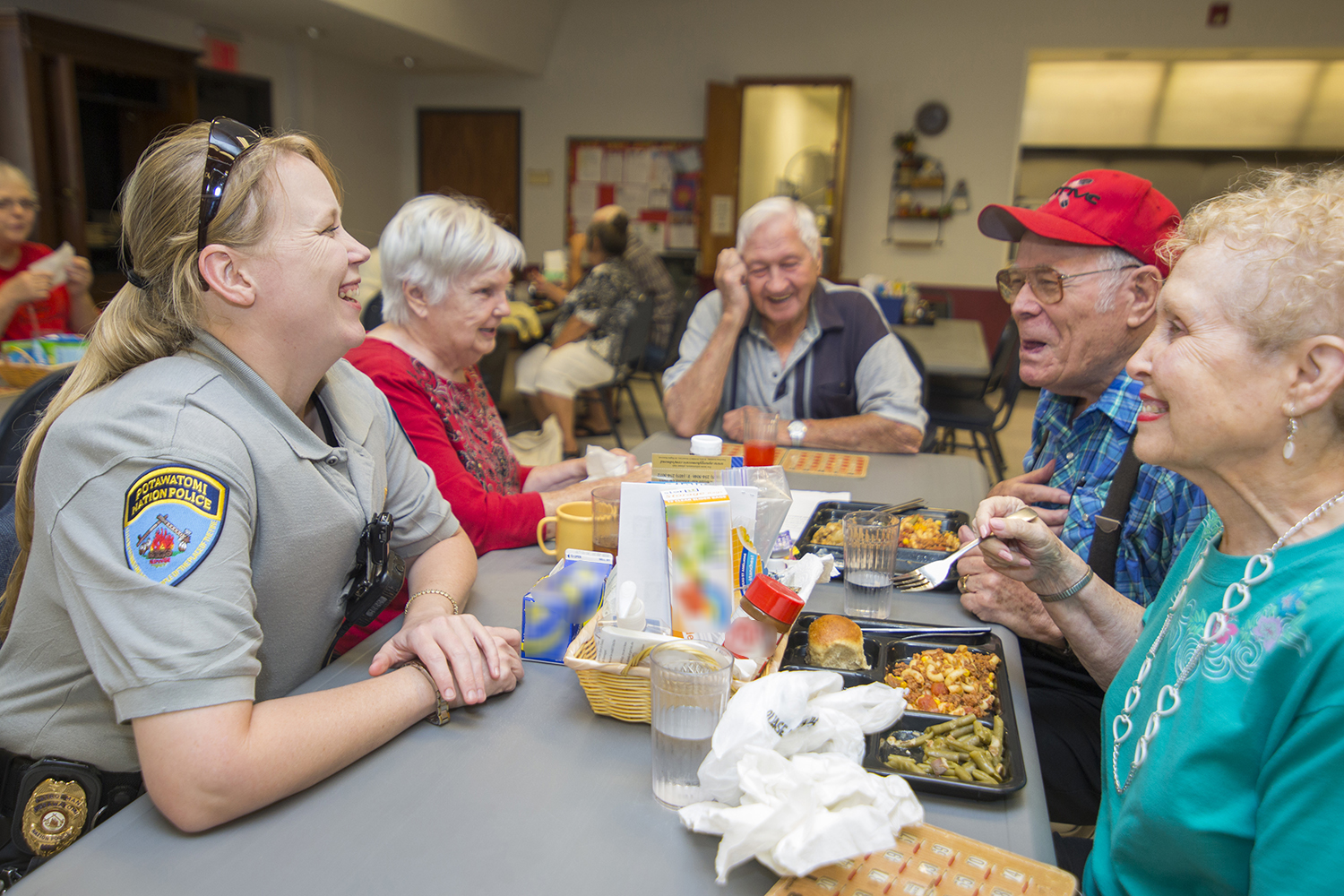20th Anniversary Photo Contest – October Winner

The COPS Office is pleased to feature the October 2015 winner of the Community Policing in Action Photo Contest—The Citizen Potawatomi Nation Tribal Police Department. Their winning photo features the department’s community service officer having lunch with the tribal elders as part of her daily community policing duties.
The Citizen Potawatomi Nation (CPN) is one of 39 federally recognized Native American tribes with headquarters in the state of Oklahoma.i Situated within Pottawatomie County, CPN is the largest employer in the county, employing approximately 2,200 people. Native Americans make up roughly 13 percent of the population in Pottawatomie County, and the CPN Tribal Police Department (CPNPD) serves all residents, regardless of race, who live in the 900-square mile tribal jurisdiction (which encompasses most of Pottawatomie County) in central Oklahoma.
Lead by Tribal Police Chief Dr. Jim Collard, the CPNPD, which is considered a mid-size police department in the state of Oklahoma, employs 26 commissioned officers, 15 dispatchers, and three administrative staff. Chief Collard, who is also an adjunct professor of regional city planning at the University of Oklahoma and has a doctorate in political economy, encourages community policing by addressing the physical environment. Using crime prevention through environmental design (CPTED) strategies that focus on the environment as a tool in reducing crime, Chief Collard emphasizes community policing through environmental design and encourages officers not only to engage with the community but also to pay close attention to space in which the community lives.
In the summer of 2012, Chief Collard created the community service officer position with the intent to pay particular attention to those most at risk: children, teens, and elders. By dedicating one officer to the elder community in particular and by designing elder communities using CPTED strategies, Chief Collard sought to improve public safety outcomes.
“We take that very seriously and design communities with that in mind. Once the physical environment is addressed effectively, we look into other areas that impact seniors like fraud,” he said.
Officer Kandi Cumbie, who is featured in this month’s winning photo, served as a community service officer for the elder community. “The picture shows one of my daily duties as a community [service] officer,” she shared via e-mail.
CPNPD officers live community policing. “We open car doors, jump car batteries; during inclement weather we go looking for stranded motorists. We have a lot of personal contact with people that have nothing to do with criminality,” Chief Collard shared.
And while he encourages CPNPD officers to engage with community members as often as possible, he maintains that police work is dangerous and has developed four guiding principles for officers to adhere to.
“I tell them, ladies and gentleman, there will be four principles which you will follow:
- Get in front of it. Anticipate where criminal activity will take place and pay attention to patrol, lighting, traffic, and other factors around the physical environment.
- Make your decisions for the right reasons. Agonize over your motives. If you concentrate on doing the right thing at the right time, all other things will fall into place.
- Maintain the highest standards both professionally and personally.
- Be kind to people. People don’t wake up and say ‘I’m going to be born into an abusive family. I want to have a substance control problem.’ Don’t talk down to people.
The CPNPD has been recognized for its great police work by many nearby and around the world. The department now provides 911 dispatching services for the entirety of Pottawatomie County and has established the CPN Tribal Police Diplomatic Security Team, which is a team of select officers who accompany visiting dignitaries during their trips to the Iron Horse Industrial Park, which recently received designation as a foreign trade zone.
The COPS Office congratulates the Citizen Potawatomi Nation Tribal Police Department for being one of the 12 winners of the COPS Office Community Policing in Action Photo Contest and for its commitment to community policing.
Written with contributions from Citizen Potawatomi Nation Tribal Police Chief Dr. Jim Collard; Jennifer Bell, Director for Public Information; John VanPool, Assistant Director for Public Information; and former CPN Officer Kandi Cumbie. Photo courtesy of the Citizen Potawatomi Nation Tribal Police Department.
Najla Haywood
Special Contributor
The COPS Office
References
i “Culture,” Citizen Potawatomi Nation, accessed September 11, 2015, http://www.potawatomi.org/culture.October Photo Contest Winner | Sutin Award Winners | Social Media 101 | SROs and Creating Safe Spaces | COPS Office at IACP
